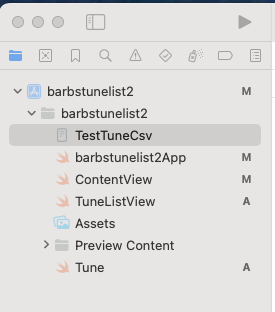When you create a csv version of your Excel data file is should save that with a file extension of .csv. It could be that your Mac is configured to not show the file extensions (that’s the default) on any file but it’s there even if you can’t see it.
The extension identifies the file type so that the operating system knows how to deal with them.
To see it, in Finder, select the file and then right click and select “Get Info”. You should see the
To change the settings on your Mac so that all file extensions are visible, see this link.
Take note of the warning about changing a file extension name because it could mean that the file is no longer readable.
Text files have a extension of .txt
JPG images have an extension of .jpg
In Xcode your ContentView has a file extension of .swift
I made an assumption that you were aware that a text file has an invisible carriage return or line terminator for each line of text. It’s there but you can’t see it so there is no need to add it to each line.
There appears to be some inconsistencies with the sample data in that if there are any columns that have no data then your csv file should show a line where there are two or more commas in succession.
In other words there should be exactly the same number of separators for each row irrespective if there is or is not data in a specific column.
Lets say you had a transaction file downloaded from your bank where you had this kind of layout:
Date,Debit,Credit,Balance,Description
11/8/2008,,1753.98,2875.77,PAYMENT THANKYOU
5/8/2008,115,,4629.75,GROCERIES
In the case of a credit transaction there would be two commas just prior as in the first transaction and in the case of a debit there would be two commas just after.
To process that csv file I created a function to do so and created a dataModel to mirror the transaction structure.
struct Transaction: Identifiable {
var id = UUID()
var date: String
var debit: Double
var credit: Double
var balance: Double
var description: String
}
My ViewModel where the data is processed:
@Observable
class ViewModel {
var transactions = [Transaction]()
func getTransactions() {
let url = Bundle.main.url(forResource: "anz", withExtension: "csv")
if let url {
do {
let data = try String(contentsOf: url)
let allRecords = Array(data.components(separatedBy: "\r\n")) // \r\n means carriage return and line feed which I needed to use in this case
var records = Array(allRecords.dropFirst()) // Remove the header record
records = records.dropLast() // Removes the last record which is blank
for record in records {
let columns = Array(record.components(separatedBy: ","))
let newTransaction = Transaction(date: columns[0], debit: Double(columns[1]) ?? 0.0, credit: Double(columns[2]) ?? 0.0, balance: Double(columns[3]) ?? 0.0, description: columns[4])
transactions.append(newTransaction)
}
print(transactions)
} catch {
print(error.localizedDescription)
}
}
}
}
I hope that gives you some idea of how to process your own csv file.
